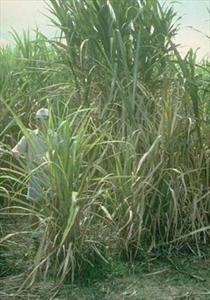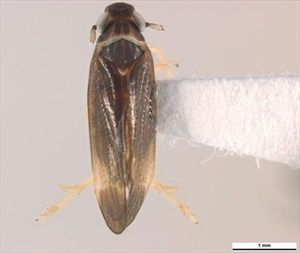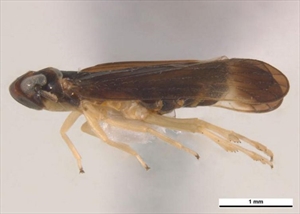Ramu stunt disease
Pacific Pests, Pathogens, Weeds & Pesticides - Online edition
Pacific Pests, Pathogens, Weeds & Pesticides
Sugarcane Ramu stunt disease (279)
Sugarcane Ramu stunt disease. Initially, the cause of the disease was thought to be a virus; later, phytoplasmas were detected (related to sugarcane white leaf phytoplasmas) in diseased plants and also in planthoppers (Eumetopina flavipes), which may spread the disease. More recently, a virus has again been suggested. Advanced RNA sequencing techniques may have found a virus belonging to the Tenuivirus group.
It is recorded from Papua New Guinea. The disease has been reported to be widespread in the country. The planthopper, Eumetopina flavipes, which likely spreads the disease is reported from Indonesia, Papua New Guinea, and the Torres Strait Islands, and in a locality near the tip of Cape York, northern Queensland.
Sugarcane. It occurs in both domesticated varieties (Saccharum officinale), wild relatives (Saccharum robustum and Saccharum spontaneum), and also some grasses.
Symptoms differ between varieties depending on their susceptibility. The disease is found in commercial varieties as well as in those grown in villages throughout the country.
In susceptible varieties, the canes are thinner than normal and internode lengths are reduced, hence the name of the disease (Photo 1). Leaves are short, stiff and erect, and show pale green to yellow streaks that vary from small specks to long stripes (2-5 mm wide) along the length of the leaf (Photo 2). Between the streaks the leaves are green. Depending on susceptibility, some or all the shoots on a stool die. Roots are stunted. Surviving plants ratoon poorly.
Symptoms take from 9-12 weeks to develop after Eumetopina planthoppers feed on the plants.
Tests have shown that Eumetopina flavipes spreads Ramu stunt disease (Photos 3&4), although other Eumetopina species may also be involved. Both adults and nymphs occur in the youngest unfolded leaves, and populations are greatest between January to March, during the wetter time of the year. The planthopper picks up the virus while feeding, there is a delay of several days before it becomes infective, but thereafter it remains infective for life.
Long distance spread of the disease is likely in stems used to make setts for planting, and by planthoppers spread in air currents.
A major outbreak of Ramu stunt disease occurred at Ramu Agri-Industries limited, Papua New Guinea, in 1986. Over 90% of the sugarcane grown was the same variety, and it was susceptible. Yields were reduced by 60%. Since then different, resistant, varieties have been planted, and good control has been achieved.
Look for plants with poor growth, stunted, and with green/yellow specks or streaks on the leaves. Other diseases of sugarcane are similar, i.e., grassy shoot, and Fiji disease; both cause stunting. But look for the grass-like tillers (grassy shoot disease), or distinctive leaf galls (Fiji disease, see Fact Sheet no. 77). Diagnosis of Ramu stunt disease from symptoms alone is difficult, and needs to be checked using a molecular test.
BIOSECURITY
Because diseases of sugarcane are unevenly distributed throughout the world, all efforts should be made to prevent their further spread. The movement of untreated consignments of sugarcane internationally for commercial purposes (food or planting) should be avoided, and exchanges of sugarcane germplasm for crop improvement programs should follow the FAO/IBPGR Technical Guidelines for the Safe Movement of Sugarcane Germplasm. Frison EA, Putter CAJ (eds.). 1993. Rome, Italy: (https://www.bioversityinternational.org/fileadmin/_migrated/uploads/tx_news/Sugarcane_259.pdf). The Guidelines stipulate the therapy and indexation that should be used.
CONTROL
In smallholder plantings, control is best achieved by removal of plants when symptoms are first seen. The young leaves should be tied together so that the planthoppers cannot escape and spread the disease, the entire plants should be removed and burnt. The difficulty with this recommendation is that growers are often unaware that the plants are diseased and that if left in the field the disease will spread. Consequently, plants are not removed.
RESISTANT VARIETIES
Control in the commercial plantations of Ramu Agri-Industries Limited is by resistant varieties, and all lines from the breeding program are assessed for resistance against a set of varieties of known field reaction to Ramu stunt disease.
CHEMICAL CONTROL
This is not a method of control that can be recommended as it is unlikely to be economic as a routine practice, especially in smallholder situations. In times of epidemics, the application of insecticides may be required in commercial plantings, and synthetic pyrethroids would be a suitable choice.
____________________
When using a pesticide, always wear protective clothing and follow the instructions on the product label, such as dosage, timing of application, and pre-harvest interval. Recommendations will vary with the crop and system of cultivation. Expert advice on the most appropriate pesticide to use should always be sought from local agricultural authorities.
AUTHOR Grahame Jackson
Information from Ramu stunt (2013) Sugar Research Australia. Information Sheet IS1 3090. (http://sugarresearch.com.au/wp-content/uploads/2017/02/Ramu_stunt_IS13090.pdf); and from CABI (2015) Sugarcane Ramu stunt disease (Ramu stunt disease). Crop Protection Compendium (https://www.cabi.org/cpc/datasheet/57173). Photos 1&2 Braithwaite KS (2010) Ramu stunt. PaDIL - (http://www.padil.gov.au). Photos 3&4 Bellis G, Fletcher M (2011) Island Sugarcane Planthopper (Eumetopina flavipes). PaDIL - (http://www.padil.gov.au).
Produced with support from the Australian Centre for International Agricultural Research under project PC/2010/090: Strengthening integrated crop management research in the Pacific Islands in support of sustainable intensification of high-value crop production, implemented by the University of Queensland and the Secretariat of the Pacific Community.
.







